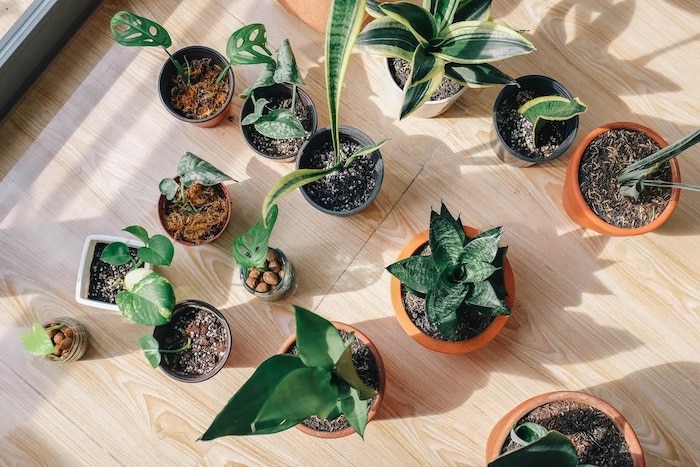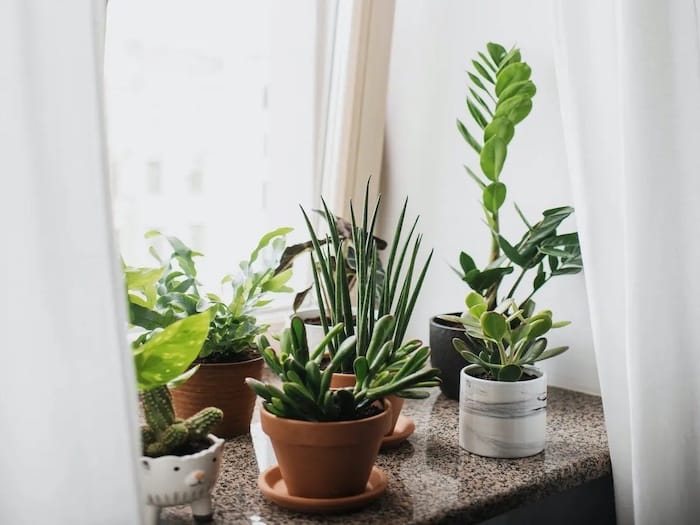Your basket is currently empty!

Quick houseplant winter care tip
“The key to maintaining your house plants in winter to try to keep them in an area that has lots of natural sunlight plus increase the humidity around the plants by standing the plants on dishes or saucers which you can add water. This will offset the drying effects of central heating which is the biggest problem for houseplants in winter months”
Why is winter houseplant care so tricky?
During the winter, a lot of elements come into play when caring for your houseplants. Since the temperatures drop and there is less daylight this time of year, houseplants — many of which come from tropical environments — die-off easier than warmer times of the year. These three things could result in your houseplant’s demise:
- Lack of light
- Too much water
- Not enough humidity
Keep these three things in mind when you’re caring for your houseplants and follow these winter houseplant care tips so you can keep your plants — succulents and air plants, too — alive and happy until spring.
1. Mist regularly

“Humidity levels will decrease during the colder months and coupled with using heaters, this can be harmful to indoor plants such as ferns and calatheas which require high humidity, says Raymond from the Cheeky Plant Co., “Group up your plants closer together and mist them regularly to keep them happy throughout winter. Using a humidifier does the same trick but will be more effective and efficient.
2. Establish a watering routine
“One of our favorite winter houseplant care tips is to adjust your watering schedules! In the winter months, our plants receive less sunshine and have a slower growth rate. The best way to get a feel for your plants’ new watering schedule is to check by sticking your finger into the soil a few inches down, and if it’s dry, it’s time for watering!” says Plant Therapy.
Also, it’s important to water your houseplants with room temperature water during this time of year. A critical step in winter houseplant care is to not shock your plant’s roots — so avoid watering your plant friends with cold water at all costs.
3. Do not over-fertilize

“For winter care in cold and dry northern areas, add a couple of drops of fertilizer to a spray bottle once a month and mist the leaves of your plants,” says Christie Pollack from Learn Plant Grow, “Your plants will enjoy the additional humidity from the mist and will absorb the fertilizer through their leaves to help keep them green without over-fertilizing them in the winter months.”
4. Add humidity where you can
“The key to maintaining your house plants in winter is to try to keep them in an area that has lots of natural sunlight plus increase the humidity around the plants by standing the plants on dishes or saucers which you can add water. This will offset the drying effects of central heating which is the biggest problem for houseplants in winter months,” says Garden Advice.
5. Look to the light

“While reducing watering is essential to keep your plants alive during the winter months, people often underestimate the importance of light. As the amount of available light goes down, your plant’s current spot might not remain suitable. Try moving your plants to a new location or add a grow light to substitute the natural light
6. Don’t forget to dust
Just like you and me, houseplants require natural light to thrive. You may want to consider relocating plants to south or west-facing windows to optimize their daylight exposure during winter months. Also, keep in mind that even thin layers of dust on a plant’s leaves can block its access to light, so use a damp cloth to gently remove dust each time you water — your plants will thank you for the TLC!”
7. Help your plants stay warm
“Keep your roots warm. Invest in a root zone heat mat to keep your plant’s root zone active all winter long! Heat mats are an easy and cheap way to make your plants thrive even in the dead of winter,” says David Flores of Hort N Culture.
Winter plant care for specific types of plants
Not every plant has the same type of care routine — so it’s key to know what type of houseplant you have. Most houseplants fall into three categories:
- Air plants
- Succulents and cacti (indoor and outdoor)
- Common houseplants (bright to low light)
Air plants

Formally known as Tillandsias, air plants continue to rise in popularity. A part of the Bromeliaceae family — there are about 650 different kinds. In nature, these plants grow on and around other plants like trees and they are native to desert, forest and mountain areas in South and Central America.
Airplants have a reputation for being relatively easy to care for, so it’s no surprise they frequent must-have plant lists. Winter houseplant care specifically for air plants should focus on making sure they get enough light and don’t get too cold.
“During winter make sure to protect your air plants from frost, keep them inside your home in colder environments. Air plants may demand more water when your heat is on creating a drier environment,” says air plant experts from Twisted Acres, “Slowly increase your water if needed.”
Succulents and cacti

There are over 10,000 succulent species in the world. Known for being hard to kill, succulents have leaves and stems that retain moisture — making them tolerant to drought periods and easy to care for.
“It’s best to provide succulents with well-draining soil for the winter,” says Chau Ly from SucculentsBox.com, “Before moving the succulents inside for the winter, water them so that they soak up the water and begin to dry out. Covering the succulents with bedsheets, row or non-woven fabric will also benefit them from the cold of winter. It is important for gardeners and plant lovers to keep in mind that many succulents do not need much water in winters, and they require at least 8 hours of indirect sunlight a day.”
If you’re looking for hardy succulents that will make it through cold winters, try these:
- Sempervivum Calcareum, Cobweb, Red Lion or Mahogany
- Stonecrop Sedum
- Corsican Stonecrop
- Sedum Golden Moss
- Dragon’s Blood Sedum
- Cape Blanco Sedum
- Ice Plant Oscularia Deltoides
- Agave Butterfly
Also, remember cacti belong to the succulent family too. Christmas cactuses and Opuntia, better known as prickly pear, both thrive during the winter season.
Other tips if your home has low-light during winter
- Check regularly if your plant needs water. Put your finger in the soil up to the first knuckle, if it’s dry, it’s time to water. Keep it splashing on until water comes out of the drainage holes. Don’t just water in the same spot. Water all the way around the plant thoroughly so the root ball gets moistened.
- Keep your windows clean — the less dirt on the window itself or the screen the better for more light to make it through.
- Rinse your plants in the sink or shower — this will help remove any dirt or dust build-up on the leaves and will help your plants absorb more nutrients.
Plants that will thrive in the winter

- Maria Arrowhead plant
- Moth Orchid
- Maidenhair Fern
- Ponytail Palms
- Pothos
- Snake Plants
- Aloe vera
- Cactus
- Snake plant
- Clivia
- Corn plant
- Jade plant
- Dragon tree
- Sweetheart plant
- Dracaena Reflexa
- Dracaena Tarzan Bush
- Cast Iron Plant Aspidistra
- Euphorbia Milii Crown of Thorns
- Christmas Cactus
- Peperomia Obtusifolia
- Chinese Evergreen
- Philodendrons
- Fiddle Leaf Fig
- Wax Plant
- ZZ plant
Take a leaf of faith this winter
All in all, by modifying your routine to combat the challenges that winter may pose — you’re giving your succulents, air plants and large, leafy green houseplants the best chance of survival. Remember, a little extra care goes a long way during the coldest months of the year and that stands not just for houseplants, but humans and animals, too. Whatever you do — don’t give up on your plants this season because spring 2022 will be here before you know it.















